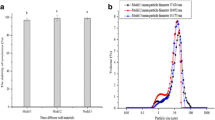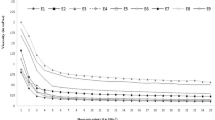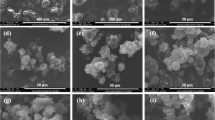Abstract
The microcapsules of fish oil were prepared through spray drying with octenyl succinic anhydride–linked starch (OSA-S) and maltodextrin (MD) as wall materials. The physical properties of microcapsules were evaluated, such as microstructure, hygroscopicity, dissolution, the average particle size, and rheological properties. It was found that the microcapsules were spherical with some wrinkle on the surface as observed by an optical microscope and a scanning electron microscope. Furthermore, the holes in the shell of microcapsules were fish oil droplets as shown in a laser confocal microscope, indicating that the fish oil microcapsules were a typically multinucleated system. In addition, there was no significant change in average particle size (0.2–0.9 μm) after 1-month storage at room temperature, and there was no chemical reaction between the wall materials and fish oil as was proven by infrared spectra. Finally, reconstituted emulsions (RCE) of microcapsule exhibited shear-thinning behavior at low shear rate, which was helpful to the processing, transportation, and storage of emulsion.






Similar content being viewed by others
References
Aghbashlo, M., Mobli, H., Madadlou, A., & Rafiee, S. (2013). Influence of wall material and inlet drying air temperature on the microencapsulation of fish oil by spray drying. Food and Bioprocess Technology, 6(6), 1561–1569.
Akhtar, M., Murray, B. S., & Dickinson, E. (2006). Perception of creaminess of model oil-in-water dairy emulsions: Influence of the shear-thinning nature of a viscosity-controlling hydrocolloid. Food Hydrocolloids, 20(6), 839–847.
AOAC (Association of Official Analytical Chemists). (2007). Official methods of analysis (17th ed.). Maryland: AOAC.
Bakry, A. M., Fang, Z., Ni, Y., Cheng, H., Chen, Y. Q., & Liang, L. (2016). Stability of tuna oil and tuna oil/peppermint oil blend microencapsulated using whey protein isolate in combination with carboxymethyl cellulose or pullulan. Food Hydrocolloids, 60, 559–571.
Barrow, C. J., Nolan, C., & Jin, Y. (2007). Stabilization of highly unsaturated fatty acids and delivery into foods. Lipid Technology, 19(5), 108–111.
Bastos, D. S., Araujo, K. G., & Leao, M. H. (2009). Ascorbic acid retaining using a new calcium alginate-Capsul based edible film. Journal of Microencapsulation, 26(2), 97–103.
Borrmann, D., Pierucci, A. P. T. R., Leite, S. G. F., & Leao, M. H. M. D. R. (2013). Microencapsulation of passion fruit (passiflora) juice with n-octenylsuccinate-derivatised starch using spray-drying. Food and Bioproducts Processing, 91(1), 23–27.
Celli, G. B., Amyl, G., & Brooks, M. S. (2015). Bioactive encapsulated powders for functional foods—A review of methods and current limitations. Food and Bioprocess Technology, 8(9), 1825–1837.
Chang, H. W., Tan, T. B., Tan, P. Y., Abas, F., Lai, O. M., Wang, Y., Nehdi, I. A., & Tan, C. P. (2018). Microencapsulation of fish oil using thiol-modified β-lactoglobulin fibrils/chitosan complex: A study on the storage stability and in vitro release. Food Hydrocolloids, 80, 186–194.
Chen, E., Cao, L., McClements, D. J., Liu, S., Li, B., & Li, Y. (2017). Enhancement of physicochemical properties of whey protein-stabilized nanoemulsions by interfacial cross-linking using cinnamaldehyde. Food Hydrocolloids, 77, 976–985.
Choe, E., & Min, D. B. (2010). Mechanisms and factors for edible oil oxidation. Comprehensive Reviews in Food Science and Food Safety, 5(4), 169–186.
Csaki, K. F. (2011). Synthetic surfactant food additives can cause intestinal barrier dysfunction. Medical Hypotheses, 76(5), 676–681.
Deangelis, P. L. (2000). Polysaccharide labeling with N-methylisatoic anhydride: Generation of ultraviolet chromophores and blue fluorophores. Analytical Biochemistry, 284(1), 167–169.
Encina, C., Márquez-Ruiz, G., Holgado, F., Giménez, B., Vergara, C., & Robert, P. (2018). Effect of spray-drying with organic solvents on the encapsulation, release and stability of fish oil. Food Chemistry, 263, 283–291.
Estevao-Silva, C. F., Ames, F. Q., Silva-Comar, F. M., Kummer, R., Tronco, R. P., Cuman, R. K. N., & Bersani-Amado, C. A. (2016). Fish oil and adjuvant-induced arthritis: Inhibitory effect on leukocyte recruitment. Inflammation, 39(1), 320–326.
Guillen, M. D., & Cabo, N. (2015). Infrared spectroscopy in the study of edible oils and fats. Journal of the Science of Food and Agriculture, 75(1), 1–11.
Hogan, S. A., O’Riordan, E. D., & O’Sullivan, M. (2003). Microencapsulation and oxidative stability of spray-dried fish oil emulsions. Journal of Microencapsulation, 20(5), 675–688.
Hu, H., Liu, W., Shi, J., Huang, Z., Zhang, Y., Huang, A., Yang, M., Qin, X., & Shen, F. (2016). Structure and functional properties of octenyl succinic anhydride modified starch prepared by a non-conventional technology. Starch - Stärke, 68(1–2), 151–159.
Jafari, S. M., Assadpoor, E., Bhandari, B., & He, Y. (2008a). Nano-particle encapsulation of fish oil by spray drying. Food Research International, 41(2), 172–183.
Jafari, S. M., Assadpoor, E., He, Y., & Bhandari, B. (2008b). Encapsulation efficiency of food flavours and oils during spray drying. Drying Technology, 26(7), 816–835.
Kagami, Y., Sugimura, S., Fujishima, N., Matsuda, K., Kometani, T., & Matsumura, Y. (2003). Oxidative stability, structure, and physical characteristics of microcapsules formed by spray drying of fish oil with protein and dextrin wall materials. Journal of Food Science, 68(7), 2248–2255.
Kondreddy, V. K. R., Anikisetty, M., & Naidu, K. A. (2016). Medium-chain triglycerides and monounsaturated fatty acids potentiate the beneficial effects of fish oil on selected cardiovascular risk factors in rats. The Journal of Nutritional Biochemistry, 28, 91–102.
Lerner, A., & Matthias, T. (2015). Changes in intestinal tight junction permeability associated with industrial food additives explain the rising incidence of autoimmune disease. Autoimmunity Reviews, 14(6), 479–489.
Liang, R., Xu, S., Shoemaker, C. F., Li, Y., Zhong, F., & Huang, Q. (2012). Physical and antimicrobial properties of peppermint oil nanoemulsions. Journal of Agricultural and Food Chemistry, 60(30), 7548–7555.
Liu, R., Zhao, S. M., Xiong, S. B., Qiu, C. G., & Xie, B. J. (2008). Rheological properties of fish actomyosin and pork actomyosin solutions. Journal of Food Engineering, 85(2), 173–179.
Liu, S., Tian, S., & Xia, K. (2016). Release condition and sustained-release behavior simulation of flaxseed oil microcapsule core material. China Oils & Fats, 41(9), 31–35.
Luca, A., Cilek, B., Hasirci, V., Sahin, S., & Sumnu, G. (2014). Storage and baking stability of encapsulated sour cherry phenolic compounds prepared from micro- and nano-suspensions. Food and Bioprocess Technology, 7(1), 204–211.
Plans, M., Wenstrup, M. J., & Rodriguez-Saona, L. E. (2015). Application of infrared spectroscopy for characterization of dietary omega-3 oil supplements. Journal of the American Oil Chemists' Society, 92(7), 957–966.
Serfert, Y., Drusch, S., Schmidt-Hansberg, B., Kind, M., & Schwarz, K. (2009). Process engineering parameters and type of n-octenylsuccinate-derivatised starch affect oxidative stability of microencapsulated long chain polyunsaturated fatty acids. Journal of Food Engineering, 95(3), 386–392.
Shaddel, R., Hesari, J., Azadmard-Damirchi, S., Hamishehkar, H., Fathi-Achachlouei, B., & Huang, Q. (2018). Use of gelatin and gum Arabic for encapsulation of black raspberry anthocyanins by complex coacervation. International Journal of Biological Macromolecules, 107(Pt B), 1800–1810.
Tonon, R. V., Grosso, C. R. F., & Hubinger, M. D. (2011). Influence of emulsion composition and inlet air temperature on the microencapsulation of flaxseed oil by spray drying. Food Research International, 44(1), 282–289.
Vardhanabhuti, B., & Ikeda, S. (2006). Isolation and characterization of hydrocolloids from monoi (Cissampelos pareira) leaves. Food Hydrocolloids, 20(6), 885–891.
Wan, Z. L., Wang, J. M., Wang, L. Y., Yang, X. Q., & Yuan, Y. (2013). Enhanced physical and oxidative stabilities of soy protein-based emulsions by incorporation of a water-soluble stevioside–resveratrol complex. Journal of Agricultural and Food Chemistry, 61(18), 4433–4440.
Yang, W., Chen, X., Chen, M., Li, Y., Li, Q., Jiang, X., Yang, Y., & Ling, W. (2017). Fish oil supplementation inhibits endoplasmic reticulum stress and improves insulin resistance: Involvement of AMP-activated protein kinase. Food & Function, 8(4), 1481–1493.
Yeo, Y., Bellas, E., Firestone, W., Langer, R., & Kohane, D. S. (2005). Complex coacervates for thermally sensitive controlled release of flavor compounds. Journal of Agricultural and Food Chemistry, 53(19), 7518–7525.
Yin, H., Pu, J., Wan, Y., Xiang, B., Bechtel, P. J., & Sathivel, S. (2010). Rheological and functional properties of catfish skin protein hydrolysates. Journal of Food Science, 75(1), E11–E17.
Zuidam, N. J., & Shimoni, E. (2010). Overview of microencapsulates for use in food products or processes and methods to make them (pp. 3–29). New York: Springer.
Funding
This work received supports from the Earmarked Fund for China Agriculture Research System (No. CARS-45-27), Fundamental Research Funds for the Central Universities (No. 2662017QD004), and Technical innovation special projects of Hubei Province (No. 2018ABA100).
Author information
Authors and Affiliations
Corresponding author
Additional information
Publisher’s Note
Springer Nature remains neutral with regard to jurisdictional claims in published maps and institutional affiliations.
Rights and permissions
About this article
Cite this article
Jia, C., Huang, S., Li, J. et al. Physical Properties of Fish Oil Microcapsules Prepared with Octenyl Succinic Anhydride–Linked Starch and Maltodextrin. Food Bioprocess Technol 12, 1887–1894 (2019). https://doi.org/10.1007/s11947-019-02342-7
Received:
Accepted:
Published:
Issue Date:
DOI: https://doi.org/10.1007/s11947-019-02342-7




